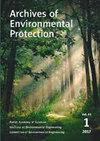不同分类群微藻厌氧消化产气量的比较
IF 1.4
4区 环境科学与生态学
Q4 ENVIRONMENTAL SCIENCES
引用次数: 5
摘要
莱茵衣藻(Chlamydomonas reinhardtii)的ch4含量为587 mL /g VS (Ward et al. 2014)。微藻生物质厌氧消化的困难可能归因于几个关键因素,如可消化底物浓度低、藻类生物质预处理的必要性、微藻生物质中的营养物质不平衡、细胞壁可降解性、利用沼气池的有限有机负荷率(OLRs)以及生物质的短期储存(Wirth et al. 2015, Montingelli et al. 2015, Klassen et al. 2015, Ward et al. 2014)。也有人认为,不能根据所使用的藻类的分类群来预测沼气的产量(Mussgnug等人,2010),因此实验必须确定单个藻类作为厌氧消化底物可以产生的沼气的数量和组成(Ward等人,2014)。本研究的目的是确定绿藻、蓝藻原核和硅藻三个微藻分类类群的使用对厌氧消化产气量和沼气组成的影响。摘要:本研究探讨了绿藻、蓝藻原核和硅藻三个微藻分类类群的产气潜力。在为期20天的中温厌氧消化批次试验中评估了沼气潜力。绿藻和蓝藻的累积产气量分别为396.21 mL/g挥发性固体(VS)和382.45 mL/g,硅藻消化的累积产气量较低,为357.07 mL/g,蓝藻的累积产气量最高,为241.25 mL ch4 /g VS,显著高于其他两种微藻(p<0.05)。蓝原核生物的甲烷含量最高,达63.08%。生物量的化学组成和沼气产量受藻类分类的影响。本文章由计算机程序翻译,如有差异,请以英文原文为准。
Comparison of biogas production from anaerobic digestion of microalgae species belonged to various taxonomic groups
tertiolecta to 587 mL CH 4 /g VS for Chlamydomonas reinhardtii (Ward et al. 2014). Diffi culties in anaerobic digestion of microalgae biomass may be attributed to several key factors, such as low concentration of digestible substrate, necessity of pretreatment of algae biomass, unbalanced nutrients in microalgae biomass, the cell wall degradability, the use of limited organic loading rates (OLRs) of the digesters as well as short term storage of biomass (Wirth et al. 2015, Montingelli et al. 2015, Klassen et al. 2015, Ward et al. 2014). It has been also postulated that biogas production cannot be predicted based on the taxonomic group of the algae that are used (Mussgnug et al. 2010), thus experiments must determine the quantity and composition of biogas that can be produced with the individual algal species as a substrate for anaerobic digestion (Ward et al. 2014). The objective of the study was to determine how the use of the three microalgae taxonomic groups of Chlorophyta , Cyanoprokaryota and Bacillariophyceae aff ects the yield and the composition of biogas produced by anaerobic digestion. Abstract: This study investigated the potential of three microalgae taxonomic groups of Chlorophyta , Cyanoprokaryota and Bacillariophyceae for biogas production. Biogas potential was assessed in mesophilic anaerobic digestion batch tests over a period of 20 days. The cumulative biogas yield (CBY) of Chlorophyta and Cyanoprocaryota was respectively 396.21 mL/g Volatile Solids (VS) and 382.45 mL/g VS. Bacillariophyceae digestion showed lower biogas production of 357.07 mL/g VS. The highest cumulative methane yield (CMY) of 241.25 mL CH 4 /g VS was recorded for Cyanoprocaryota biomass, which was signifi cantly higher (p<0.05) than the other two types of microalgae. The highest methane content in biogas of 63.08% was observed with Cyanoprokaryota. Chemical composition of biomass as well as biogas productivity are infl uenced by algal taxonomy.
求助全文
通过发布文献求助,成功后即可免费获取论文全文。
去求助
来源期刊

Archives of Environmental Protection
ENVIRONMENTAL SCIENCES-
CiteScore
2.70
自引率
26.70%
发文量
0
期刊介绍:
Archives of Environmental Protection is the oldest Polish scientific journal of international scope that publishes articles on engineering and environmental protection. The quarterly has been published by the Institute of Environmental Engineering, Polish Academy of Sciences since 1975. The journal has served as a forum for the exchange of views and ideas among scientists. It has become part of scientific life in Poland and abroad. The quarterly publishes the results of research and scientific inquiries by best specialists hereby becoming an important pillar of science. The journal facilitates better understanding of environmental risks to humans and ecosystems and it also shows the methods for their analysis as well as trends in the search of effective solutions to minimize these risks.
 求助内容:
求助内容: 应助结果提醒方式:
应助结果提醒方式:


